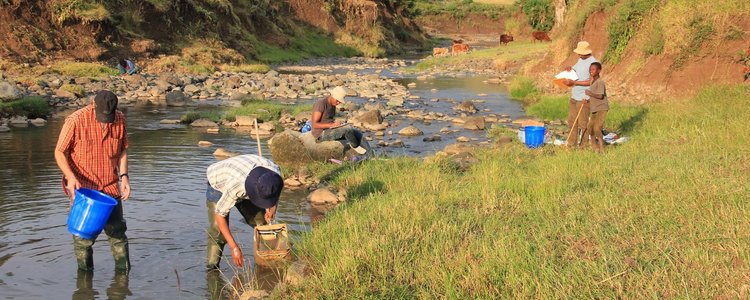Rivers belong to the most important and at the same time, the most endangered ecosystems as they are affected by a variety of anthropogenic activities (e.g. water abstraction, pollution, habitat degradation, deforestation, hydropower). The sustainable management of surface waters quality is a key societal issue, which requires proactive measures designed to resolve specific regional problems. Proper monitoring of rivers will increase water use efficiency and planning a range of appropriate utilisation and restoration activities.
However, before this can be fully achieved, there is a need to better understand river system functioning and the biodiversity that directly depends on them. This knowledge is needed because the assessment of the ecological integrity of rivers and streams is based on physical/chemical parameters and biological indicators (organisms that reflect certain environmental conditions). So far, this knowledge is largely missing in the Afrotropical region. Hence, there is an urgent need to establish baseline data and make these data available to researchers, NGOs, and decision-makers.
To link the biodiversity of the riverine environment and human-induced stressors, an important objective of the LARIMA project was to provide detailed information on different groups of aquatic organisms. For the first time, a long Ethiopian river (the Awash River with more than 1,200 km in length) was analysed regarding its biota, physico-chemical and physiographic parameters (Longitudinal river zonation in the tropics: Examples of fish and caddisflies from the endorheic Awash River, Ethiopia). This helped to describe zonation patterns of aquatic organisms (fish and caddisflies) and link them to abiotic features along the entire river course. Interestingly, in its headwaters, the comparison of different biological indicators (macroinvertebrates and microbes) found contrasting results which underline the urgent need for management actions at the catchment scale to reduce the high risk of water-borne diseases for humans. These investigations not only contributed to a better understanding of river systems in the Afrotropical region, but also resulted in the discovery of a fish species (Enteromius yardiensis), caddisflies (Trichoptera), mayflies (Ephemeroptera) and water bugs (Heteroptera) new for science as an important contribution to the knowledge of the overall biodiversity in East-Africa.
Sustainable Highland Rivers Management in Ethiopia | LARIMA: A joint project of the Ethiopian Institute of Agriculture Research at National Fishery and Aquatic Life Research Center, Sebeta (EIAR- NFALRC), Ambo University (AU), and the University of Natural Resources and Life Sciences, Vienna (BOKU) under the coordination of Wolfram Graf, Aschalew Lakew, and Asefa Keneni – funded by APPEAR.
- Related open access publications:
Terefe Y., Vitecek S., and Graf W. (2018). Description of the larva of Oecetis mizrain Malicky & Graf, 2012 (Trichoptera, Leptoceridae) and Lepidostoma scotti (Ulmer, 1930) (Trichoptera, Lepidostomatidae) from Chilimo Forest, Central Ethiopia. ZooKeys 766: 63–77. https://doi.org/10.3897/zookeys.766.24544
Kebede G., Mushi D., Linke R.B., Dereje O., Lakew A., Hayes D.S., Farnleitner A.H., and Graf W. (2020). Macroinvertebrate indices versus microbial fecal pollution characteristics for water quality monitoring reveals contrasting results for an Ethiopian river. Ecological Indicators 108: 105733. http://dx.doi.org/10.1016/j.ecolind.2019.105733
Englmaier G.K., Tesfaye G., and Bogutskaya N.G. (2020). A new species of Enteromius (Actinopterygii, Cyprinidae, Smiliogastrinae) from the Awash River, Ethiopia, and the reestablishment of E. akakianus. ZooKeys 902: 95–138. https://doi.org/10.3897/zookeys.902.39606
Yanai Z., Graf W., Terefe Y., Sartori M., and Gattolliat J.-L. (2020). Re-description and range extension of the Afrotropical mayfly Cloeon perkinsi (Ephemeroptera, Baetidae). European Journal of Taxonomy 617: 1–23. https://doi.org/10.5852/ejt.2020.617
Englmaier G.K., Hayes D.S., Meulenbroek P., Terefe Y., Lakew A., Tesfaye G., Waidbacher H., Malicky H., Wubie A., Leitner P., Graf W. (2020). Longitudinal river zonation in the tropics: Examples of fish and caddisflies from the endorheic Awash River, Ethiopia. Hydrobiologia 847(19): 4063–4090. https://doi.org/10.1007/s10750-020-04400-0
Englmaier G.K., Viñuela Rodríguez N., Waidbacher H., Palandačić A., Tesfaye G., Gessl W., and Meulenbroek P. (2020). New data on Garra makiensis (Cyprinidae, Labeoinae) from the Awash River (Ethiopia) with remarks on its relationships to congeners on the Arabian Peninsula. ZooKeys 984: 133–163. https://zookeys.pensoft.net/article/55982/
Peter Malzacher "New records and taxa of Caenidae (Insecta: Ephemeroptera) from Ethiopia, with particular regard to the River Awash region," Integrative Systematics: Stuttgart Contributions to Natural History 4(1), 1-23, (30 June 2021). https://doi.org/10.18476/2021.826615
Zettel, H. (2021): Aphelocheirus aschalewi nov.sp., first record of Aphelocheiridae (Hemiptera, Heteroptera) from Ethiopia. Linzer biol. Beitr. 52/2 1139-1143.
Tesfaye, G., Curto, M., Meulenbroek, P. et al. Genetic diversity of Nile tilapia (Oreochromis niloticus) populations in Ethiopia: insights from nuclear DNA microsatellites and implications for conservation. BMC Ecol Evo 21, 113 (2021). https://doi.org/10.1186/s12862-021-01829-2

